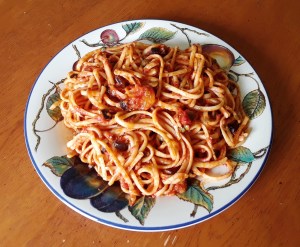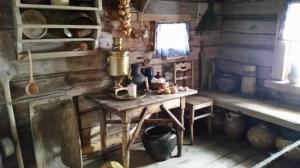 Danny Tedesco, Joe’s younger brother, is the black sheep of the family. He’s long on money-making schemes and short on work ethic. And although Danny and Joe get along—they really do love each other—more often than not, Danny is a bit of a thorn in Joe and Shirley’s side.
Danny Tedesco, Joe’s younger brother, is the black sheep of the family. He’s long on money-making schemes and short on work ethic. And although Danny and Joe get along—they really do love each other—more often than not, Danny is a bit of a thorn in Joe and Shirley’s side.
Joe springs it on Shirley that Danny and his new girlfriend are coming to dinner, and Shirley is not at all happy. She doesn’t want to cook for her loser brother-in-law and the latest bimbo he’s picked up Lord knows where. Unfortunately, Danny is family and must be welcomed. In defiance of the dinner party, Shirley announces that she’ll make spaghetti alla puttanesca. Joe questions her choice, but his strong-willed wife has made up her mind.
The elegant sounding dish is really quite delicious, and Shirley’s choice wasn’t altogether a bad one. If you aren’t familiar with the history of the dish and/or you don’t speak Italian, allow me to explain. Spaghetti alla puttanesca literally means spaghetti in the style of a whore. According to various websites, the dish was created in Naples and dates back to the mid-twentieth century. One legend says the meal was quick and cheap for prostitutes to make between customers while another says the robust aroma drew clients in.
I lean more toward the belief that Italians use the word puttana as an all-purpose swear word the way Americans use sh*t. It would be like saying, “I threw a whole bunch of sh*t into the pan and came up with this.” Reinforcing my opinion is the fact that I watched a cooking show years ago where the Italian Momma taught the host the meaning of, “I just sh*t.” Much laughing was involved, but Momma explained it meant to take stuff from the cupboard and toss it in the pot without the benefit of a recipe.
There are variations to the recipe with a particular ingredient omitted or added based on preference and locale. The sauce is traditionally served over spaghetti, but can also be served over linguine (as pictured above), penne, or bucatini. Trust me when I encourage you to use all the ingredients listed even if you don’t think you’ll enjoy them. I admit there was one on the list that made me hesitate, but ever since I discovered spaghetti alla puttanesca, I have come to love the simple, flavorful dish.
Shirley Tedesco’s Spaghetti alla Puttanesca
1 lb. dried spaghetti
Sea Salt
8 T extra virgin olive oil (reserve 2 T)
6 – 8 large cloves garlic, thinly sliced or finely chopped
8 – 10 anchovy fillets (packed in oil), finely chopped
1 – 2 large pinches red pepper flakes
½ c capers, coarsely chopped (press them dry in a paper towel first)
½ c pitted black olives, drained and coarsely chopped
1 – 28 oz. can whole peeled tomatoes with the juice (recommend San Marzano), crushed by hand
Minced parsley or basil for garnish
½ – 1 T Pecorino Romano or Parmesan cheese, finely grated (optional)
Ground black pepper (I used quad-colored peppercorns)
Place the spaghetti in a large, deep skillet or sauté pan and cover with water. Add a pinch of sea salt. Bring it to a boil over high heat, stirring occasionally to keep the pasta from sticking.
In a medium skillet, combine 6 T olive oil, anchovies, garlic, and red pepper flakes, and cook over medium heat until the garlic turns a light golden color, approximately five minutes. Adjust the heat as necessary to keep the mixture sizzling without burning the garlic. Add the capers and olives, and stir to combine.
Stir in the crushed tomatoes and juice and bring to a light simmer. Continue simmering the sauce until the spaghetti is cooked to al dente (about 1 minute less than recommended on the package). Use tongs or a pasta spoon to transfer the spaghetti to the sauce. Reserve 1 cup of cooking water.
Add a few tablespoons of cooking water to the sauce and increase the heat to bring the spaghetti and sauce to a vigorous simmer. Add more cooking water as necessary to keep the sauce loose until the pasta is al dente (about 1 – 2 minutes). The spaghetti cooks more slowly in the sauce, and the starchy cooking water helps the sauce to thicken and cling nicely to the pasta.
Season lightly with sea salt (anchovies, olives, and capers are quite salty already) and heartily with black pepper. Stir in the remaining 2 T olive oil and parsley or basil. Some purists say that cheese has no place in puttanesca, but I find Pecorino Romano or Parmesan perfectly complements the dish. If using cheese, add it at this point and stir to combine. Transfer the spaghetti alla puttanesca to a platter or individual dishes and serve with more grated cheese if desired.
Enjoy!


